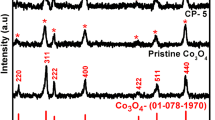Abstract
A general characteristic of processes that occur during anodic oxidation of phenylacetic and phenylpropionic acids and derivatives of α- and β-amino acids on platinum electrodes in methanol and mixed pyridine–methanol solutions is given. From preparative electrolyses in stagnant and flow-through reactors, conditions are determined under which the dimerization (Kolbe electrosynthesis) is least complicated by the formation of polymer products. Properties of removed electrodes, on which stable polymer films formed during the electrosynthesis, are examined. For films formed in certain conditions on the cathode, the presence of a quasi-reversible redox transition is demonstrated. Such films contain disperse platinum codeposited with polymer as a result of the anode dissolution in the cells with common compartments. In principle, the film-modified electrodes can be used for controlling anodic decarboxylation.
Similar content being viewed by others
REFERENCES
Schäfer, H.J., Comprehensive Organic Synthesis: Selectivity, Strategy, and Efficiency in Modern Organic Chemistry, Trost, B.M. and Flemini, I., Eds., Oxford: Pergamon, 1991, vol. 3, p. 633.
Eberson, L., in Organic Electrochemistry: An Introduction and a Guide, Baizer, Ed., New York: Marcel Dekker, 1973.
Weiper-Idelmann, A., Kahmen, M., Schäfer, H.J., and Gockeln, M., Acta Chem. Scand., 1998, vol. 52, p. 672.
Sugiya, M. and Nohira, H., Bull. Chem. Soc. Jpn., 2000, vol. 73, p. 705; Chem. Lett., 1998, p. 479.
Volckaerts, E., Geise, H.J., Daelemans, F., and Claereboudt, H., Bull. Soc. Chim. Belg., 1992, vol. 101, p. 497.
Linstead, R.P., Shephard, B.R., and Weedon, B.C.L., J. Chem. Soc., 1951, p. 2854.
Linstead, R.P., Shephard, B.R., and Weedon, B.C.L., J. Chem. Soc., 1952, p. 3624.
Coleman, J.P., Lines, R., Utley, J.H.P., and Weedon, B.C.L., J. Chem. Soc., Perkin Trans. 2, 1974, p. 1064.
Ross, S.D. and Finkelstein, M., J. Org. Chem., 1969, vol. 34, p. 2923.
Vijh, A.K. and Conway, B.E., Chem. Rev., 1967, vol. 67, p. 623.
Fioshin, M.Ya. and Mirkind, L.A., Itogi Nauki Tekh., Ser.: Elektrokhimiya, 1972, vol. 8, p. 273.
Mirkind, L.A. and Tyurin, Yu.M., Elektrosintez i mekhanizm organicheskikh reaktsii (Electrosynthesis and Mechanism of Organic Reactions), Moscow: Nauka, 1973, p. 181.
Andrieux, C.P., Gonzalez, F., and Saveant, J.-M., J. Am. Chem. Soc., 1997, vol. 119, p. 4292.
Yan, J.-F., Fedkiw, P.S., and Law, C.G., J. Appl. Electrochem., 1996, vol. 26, p. 175.
Gordon, A.J. and Ford, R.A., The Chemist's Companion: A Handbook of Practical Data, Techniques, and References, New York: Wiley, 1972.
Beilstein Handbook of Organic Chemistry, Berlin: Springer, 1988, vol. 14, suppl. II, p. 302.
Beilstein Handbook of Organic Chemistry, Berlin: Springer, 1988, vol. 14, suppl. II, p. 493.
Lokensgard, J., Fisher, J., and Bartz, W., J. Org. Chem., 1985, vol. 50, pp. 26, 5609.
Beilstein Handbook of Organic Chemistry, Berlin: Springer, 1982, vol. 5, p. 598.
Beilstein Handbook of Organic Chemistry, Berlin: Springer, 1982, vol. 5, p. 616.
Electroactive Polymer Electrochemistry, Lyons, M.E.G., Ed., New York: Plenum, 1994, part 1; 1996, part 2.
Fedorova, A.I. and Vasina, S.Ya, Elektrokhimiya, 1967, vol. 3, p. 742.
Author information
Authors and Affiliations
Rights and permissions
About this article
Cite this article
Smirnova, N.V., Neganova, E.G., Astaf'ev, E.A. et al. Strategy for Controlling the Kolbe Electrosynthesis in the Presence of Aromatic Fragments and Amino Groups in the Molecule. Russian Journal of Electrochemistry 37, 893–898 (2001). https://doi.org/10.1023/A:1011936024454
Issue Date:
DOI: https://doi.org/10.1023/A:1011936024454




